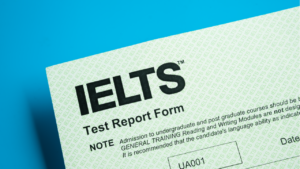Describe a chocolate you didn’t like is a popular IELTS Speaking Cue Card topic that allows you to share your personal experience and express your thoughts and opinions about a particular food item. The ability to speak fluently, coherently and accurately on a given topic is crucial in the IELTS Speaking Test, and the Cue Card segment is an excellent opportunity for you to do so.
In this blog, we will guide you on effectively answering this cue card topic by sharing tips and sample answers to help you prepare for the IELTS Speaking Test. So, let’s get started and explore how to make your Cue Card section genuine, interactive and practical.
Leap Advantage Virtual Spot Offer Event on May 10th 2024

Last call to secure your spot for Masters in STEM Program in the US for Fall ’24 exclusively for graduates and above.
Leap Advantage Virtual Spot Offer Event on May 10th 2024
Last call to secure your spot for Masters in STEM Program in the US for Fall ’24 exclusively for graduates and above.

IELTS Speaking Test Part 2: Cue Card
In the IELTS Speaking Test Part 2, also known as the Cue Card round, you are given a cue card or a task card with a topic and a set of questions related to that topic.
You will be given one minute to prepare and speak on the topic for two minutes, answering all the questions mentioned in the task card.
The main objective of this round is to assess your ability to speak fluently, coherently, and spontaneously and to organise your thoughts effectively.
The examiner evaluates the candidate’s ability to express their ideas clearly, use a wide range of vocabulary, form grammatically correct sentences, and use appropriate pronunciation and intonation.
The Cue Card round is an integral part of the IELTS Speaking Test and carries significant weightage in the overall scoring of the test.
Therefore, you must practise and prepare well for this round to perform on test day to the best of your abilities.
Sample Answer 1: Describe a Chocolate You Didn’t Like
Introduction
In 2018, my family and I went on a trip to Paris, and during our shopping adventure, I came across a beautiful chocolate bar.
What was it?
I found a cute little shop. Inside, I saw a chocolate bar that looked really pretty, with bright colours on the wrapper that made it stand out from the others. I liked how it looked so much that I immediately bought it without checking the ingredients.
What did it taste like?
I was excited to try something unique from Paris, so I tasted it. However, to my surprise, the experience was not as delightful as expected. The chocolate had an unusual taste – a combination of fruits and nuts. I immediately regretted buying it.
And explain why you didn’t like it.
The taste was disappointing, especially considering the anticipation created by the lovely wrapping. I have never really liked the fruit and nuts flavour, so I think I should have read and checked the chocolate carefully before buying.
Conclusion
I gained an experience in the importance of avoiding impulsive purchases. Therefore, the next time I happen to be in a chocolate shop, I plan to take my time before making a purchase decision.
Crack IELTS Exam in first attempt

Attend Leap’s free masterclass to get tips, tricks and advance strategies to crack IELTS exam in first attempt
Crack IELTS Exam in first attempt
Attend Leap’s free masterclass to get tips, tricks and advance strategies to crack IELTS exam in first attempt

Sample Answer 2: Describing a Chocolate You Didn’t Like
Introduction
I’m not crazy about chocolates, but there’s this one chocolate I tried that I didn’t enjoy.
What was it?
It happened during a casual shopping trip with a friend. She bought this expensive-looking heart-shaped chocolate covered in shiny gold paper.
When did you taste it? And What does it taste like?
I was annoyed because she didn’t tell me about the pricey chocolate. Still, she was excited to share. I took a bite, which tasted weird – a mix of bitter and sour.
And explain why you didn’t like it.
The taste wasn’t what we expected and wasn’t worth the money. We couldn’t even find any nuts in it. Just plain chocolate that didn’t taste good.
Conclusion
My friend and I realised that sometimes expensive chocolates don’t guarantee good taste. We both wished we had chosen something else. It was a lesson for both of us about picking chocolates more carefully.
Part 3 Questions: Describe a Chocolate You Didn’t Like
The third part of the IELTS Speaking Test involves a more detailed discussion of the topics you addressed. To excel in this section, it’s crucial to respond to the questions attentively, providing detailed and well-explained answers that enhance the overall strength of your response.
In this case, let’s explore the follow-up questions related to popular chocolate flavours, children’s preferences for chocolates, and the popularity of chocolate cakes.
Q1. What are some popular chocolate flavours in your country?
A1. In my country, a variety of chocolate flavours are popular. Classic choices such as milk chocolate and dark chocolate are widespread. Additionally, flavours like hazelnut, caramel, and fruit-infused chocolates have recently gained popularity.
Q2. Do children like chocolates?
A2. Children universally seem to have a fondness for chocolates. Chocolates’ sweet and indulgent nature appeals to them, making it a widely enjoyed treat among kids. Whether in the form of bars, candies, or even desserts, chocolates often hold a special place in children’s hearts.
Q3. Do people like chocolate cakes?
A3. Chocolate cakes are trendy among people of all ages. The rich and decadent flavour of chocolate enhances the overall appeal of cakes, making them a preferred choice for various occasions. Whether it’s a birthday celebration, a festive gathering, or a simple dessert after a meal, chocolate cakes often are preferred.
Q4. Should chocolates always stick to traditional flavours, or is experimentation with unique combinations acceptable?
A4. I believe there’s room for both traditional and experimental flavours in the world of chocolates. While classic flavours hold a timeless charm, experimentation can lead to exciting discoveries and cater to diverse tastes. However, such combinations must be well-balanced, ensuring a harmonious blend of flavours. Striking the right balance allows for innovation without compromising the fundamental appeal of chocolate.
Q5. Is it difficult to make chocolate at home?
A5. No, making chocolate at home doesn’t have to be hard. It can be quite simple! You can start with basic recipes that require just a few ingredients, like cocoa powder, sugar, and butter. There are easy-to-follow recipes online, and you don’t need fancy equipment. With patience and practice, anyone can enjoy the fun of making delicious chocolate treats right in their kitchen.
Tips for preparing for the Cue Card
Here are eight specific tips to help effectively prepare for the Cue Card section of the IELTS Speaking Test
1. Practice Regularly with Cue Card Topics
Engage in regular practice sessions where you simulate the actual test environment. Use a variety of Cue Card topics to enhance your ability to speak coherently and fluently.
2. Time Management
During your practice sessions, ensure that you stick to the time limit of one minute for the preparation and two for speaking. Practice managing your time effectively to cover all aspects of the given topic.
3. Use a Variety of Vocabulary
Work on expanding your vocabulary. Utilise a range of words and expressions to convey your ideas effectively. This will showcase your language proficiency and help you avoid repetition.
4. Organise Your Response
Structure your response logically. Begin with a brief introduction, cover the main points, and conclude your response. This organisation demonstrates clarity and coherence in your speaking.
5. Record and Evaluate Yourself
Record your practice sessions and listen to them critically. Identify areas where you can improve pronunciation, intonation, and clarity. A self-evaluation is a powerful tool for continuous improvement.
6. Focus on Pronunciation and Intonation
Pay special attention to your pronunciation and intonation. Precise and accurate pronunciation contributes significantly to effective communication. Practice with phonetic exercises if needed.
7. Create Cue Card Notes
During the one-minute preparation time, jot down key points or bullet notes on the topic. This will serve as a quick reference guide during your two-minute speaking time and help you stay on track.
8. Diversify Topics in Your Practice
Familiarise yourself with a wide range of Cue Card topics. Practice discussing personal experiences, opinions, and abstract ideas. This variety will prepare you for any topic that may come up during the actual test.
Remember, consistent and focused practice is key to success in topics like ‘Describe a chocolate you didn’t like in the Cue Card section of the IELTS Speaking Test.
Tailor your practice sessions to address specific areas of improvement based on feedback or self-assessment.
Do you want to score a higher band in the IELTS Speaking Test?
Sign up for Leap Scholar’s IELTS Demo to interact with a Master Cambridge-certified IELTS trainer!
What will you get?
- A 30-minute long session
- A band predictor test
- A personalised IELTS prep plan and more!
Don’t miss out on the opportunity to boost your IELTS scores!
Frequently Asked Questions
Q. What are some common topics for IELTS Cue Card speaking?
A. The IELTS Cue Card speaking topics can vary but generally revolve around personal experiences, opinions, or views on a particular topic. The topics can range from describing a place, a person, an event, or a memorable experience.
Q. How many parts are in the IELTS Speaking Test?
A. The IELTS Speaking Test consists of three parts. The first part includes an introduction and briefly discusses personal interests and experiences. The second part requires you to speak for a few minutes on a given topic. The third part involves a more in-depth discussion based on the topic of the second part.
Q. How can I start IELTS practice at home?
A. To start IELTS practice at home, you can start understanding the test format and structure. You can also find sample tests and practice materials online or in IELTS preparation books. Additionally, you can join online study groups or hire a tutor to guide you through the process.
Q. Is it OK to speak slowly in IELTS?
A. Yes, speaking slowly in the IELTS speaking test is perfectly fine. The most important thing is to speak clearly and coherently so the examiner can understand you. Speaking slowly is an advantage as it gives you more time to think about your answers and to express your ideas more effectively.
Q. Where can I find the practice sample test papers for the IELTS Speaking Test?
A. There are various resources available for IELTS Speaking Test practice, such as online platforms, books, and the official IELTS website. These practice tests can help you familiarise yourself with the test format and the types of questions you can expect in the actual test.
Q. What can I do if I do not understand the question?
A. If you do not understand a question during the IELTS Speaking Test, you can ask the examiner to repeat or rephrase the question or ask for clarification. It’s crucial to ensure you understand the question before answering it, as this will help you provide a clear and accurate response.







